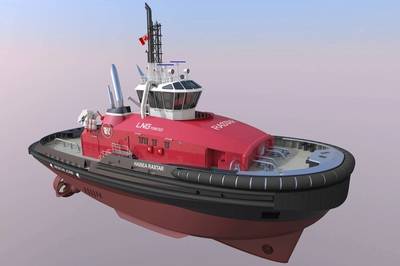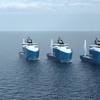Schottel Propulsion for Five Turkish-built, Canada-bound Tugs
German propulsion firm Schottel has secured an order to deliver a total of ten rudder propellers and two transverse thrusters for five tugs that will serve the LNG carriers stopping at an LNG export facility in Canada.
Schottel's equipment will be installed on two LNG-fuelled escort tugs, as well as in three battery-powered harbor tugs.
Ordered by Canadian HaiSea Marine, a partnership between the Haisla Nation and Seaspan ULC, the vessels will provide ship assist and towing services to LNG carriers stopping at a new LNG export facility in Kitimat, British Columbia. All five tugs are scheduled to enter service in 2023.
The fleet will consist of two RAstar 4000-DF dual-fuel (LNG and diesel) escort tugs and three ElectRA 2800 electric harbor tugs. Designed by Robert Allan Ltd. (RAL), the LNG tugs will be built in Sanmar Shipyards Altinova while the electric tugs will be built in Sanmar Shipyards Tuzla.
Measuring 40 m in length and providing around 100 t of bollard pull, it is said they will be the most powerful escort tugs on Canada’s west coast. In addition, they will feature an exhaust after-treatment system in full compliance with IMO Tier III emissions standards.
Each of the two dual-fuel escort tugs will be equipped with two Schottel rudder propellers type SRP 610 CP featuring an input power of 3,000 kW with a propeller diameter of 3.2 m. To further enhance maneuverability, each vessel will be fitted with a Schottel transverse thruster type STT 170 (250 kW).
Each of the three battery-electric tugs will be propelled by two Schottel CombiDrives type SCD 460 (2,100 kW each) with four-bladed propellers with a diameter of 2.6 m. This thruster setup enables the harbor tugs to achieve a bollard pull of approximately 70 t.
The ElectRA 2800 harbor tugs will operate in unison at a new LNG export facility and will be “first-of-their-class” battery-powered electric tugs. They are designed to perform their regular ship-berthing and unberthing missions using on battery power with a capacity of around 5,240 kWh. The ElectRA 2800 harbor tugs will be 28 meters long,
With an ample supply of clean hydroelectric power available at Kitimat, the harbor tugs will be able to recharge from dedicated shore charging facilities at their berths between dockings, effectively resulting in near-zero-emissions when running on batteries, Schottel said, adding that GHG emissions from the new tugs are expected to be significantly lower (54% and 24% respectively) than diesel-powered alternatives. Schottel did not share the financial details of the deal.














